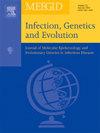巴基斯坦卡拉奇5岁以下儿童呼吸道合胞病毒株的系统发育和系统动力学分析
IF 2.6
4区 医学
Q3 INFECTIOUS DISEASES
引用次数: 0
摘要
呼吸道合胞病毒(RSV)是全世界婴儿发病和死亡的主要原因之一,特别是在巴基斯坦。迄今为止,很少有研究探索巴基斯坦不同地区的RSV流行病学。然而,没有人对RSV菌株进行全面的系统发育和系统动力学分析。本研究对巴基斯坦卡拉奇5岁以下儿童RSV株进行了全面的遗传和系统动力学分析。方法回顾性收集155例经qpcr证实的RSV感染患儿的鼻咽拭子样本。采用RSV糖蛋白基因特异性引物进行RSV基因分型。采用BLAST和最大似然(ML)系统发育方法进行RSVA和RSVB基因分型。同样,采用ML系统发育聚类分析分析与其他RSV菌株的关系。利用MEGA7软件计算RSVA和RSVB的平均遗传多样性和分化系数。此外,使用贝叶斯MCMC分析估计RSV基因型A和B的最共同最近祖先(tMRCA)和有效群体大小的时间。最后,使用FUBAR和NetNGlyc/NetOGlyc工具进行位点选择压力和糖基化分析。结果155条、98条和57条序列分别为RSVA和RSVB。估计RSVA和RSVB的tMRCA分别在2002年和2005年左右。RSVA序列形成了两个NA1基因型簇,分别包含95个和3个序列。RSVB形成3个簇,其中24个和2个序列分别与BA9和BA12基因型聚在一起,31个序列形成一个独特的簇。RSVA和RSVB糖蛋白基因序列在多个位点表现出N-和O-糖基化和选择压力。RSV B的每位点(π)核苷酸多样性(0.042)略高于RSVA(0.019)。结论RSVA和RSVB菌株在巴基斯坦表现出不同的基因型聚集,其估计的tMRCA存在差异。此外,两种基因型在特定位点都表现出糖基化和选择压力,其中RSVB在每个位点表现出更高的核苷酸差异(π),表明其有可能经历进一步的进化变化和适应。总的来说,本研究为RSV分子流行病学提供了独特的见解。该研究还可能有助于提高我们对RSV进化变化和新基因型在全球不同地区和巴基斯坦境内出现的理解。本文章由计算机程序翻译,如有差异,请以英文原文为准。
Phylogenetic and phylodynamic analysis of respiratory syncytial virus strains circulating in children less than five years of age in Karachi-Pakistan
Background
Respiratory syncytial virus (RSV) is one of the leading causes of infant morbidity and mortality worldwide, especially in Pakistan. To date, few studies have explored RSV epidemiology in different areas of Pakistan. However, none have performed comprehensive phylogenetic and phylodynamic analyses of RSV strains. This study presents a comprehensive genetic and phylodynamic analysis of RSV strains in children less than five years old in Karachi, Pakistan.
Methods
This study used retrospectively collected nasopharyngeal (swab) samples from 155 children with qPCR-confirmed RSV infection. The samples were used to perform RSV genotyping using PCR employing RSV glycoprotein gene-specific primers. The RSVA and RSVB genotyping was performed using BLAST and Maximum-likelihood (ML) phylogenetic methods. Similarly, the relationship with other RSV strains was analyzed using ML phylogenetic cluster analysis. The RSVA and RSVB mean genetic diversity and coefficient of differentiation were calculated using MEGA7 software. Furthermore, the time to the most common recent ancestor (tMRCA) and effective population size of RSV genotypes A and B were estimated using a Bayesian MCMC analysis. Finally, site selection pressure and glycosylation analyses were performed using FUBAR and NetNGlyc/NetOGlyc tools.
Results
Out of 155, 98 and 57 sequences were RSVA and RSVB, respectively. The tMRCA was estimated to be around 2002 and 2005 for RSVA and RSVB, respectively. RSVA sequences formed two NA1 genotype clusters, comprising 95 and three sequences, respectively. RSVB formed three clusters, where 24 and two sequences clustered with BA9 and BA12 genotypes, respectively, while 31 sequences formed a unique cluster. The RSVA and RSVB glycoprotein gene sequences exhibited N- and O- glycosylation and selection pressure at several sites. RSV B exhibited slightly higher (0.042) nucleotide diversity per site (π) as compared to RSVA (0.019).
Conclusions
Our results suggest that RSVA and RSVB strains in Pakistan exhibit distinct genotypic clusters and differ in their estimated tMRCA. Additionally, both genotypes showed glycosylation and selection pressure at specific sites, with RSVB exhibiting higher nucleotide divergence per site (π), indicating its potential to undergo further evolutionary changes and adaptation. Overall, this study provides unique insights into RSV molecular epidemiology. The study may also help improve our understanding of RSV evolutionary changes and the emergence of new genotypes in different regions worldwide and within Pakistan.
求助全文
通过发布文献求助,成功后即可免费获取论文全文。
去求助
来源期刊

Infection Genetics and Evolution
医学-传染病学
CiteScore
8.40
自引率
0.00%
发文量
215
审稿时长
82 days
期刊介绍:
(aka Journal of Molecular Epidemiology and Evolutionary Genetics of Infectious Diseases -- MEEGID)
Infectious diseases constitute one of the main challenges to medical science in the coming century. The impressive development of molecular megatechnologies and of bioinformatics have greatly increased our knowledge of the evolution, transmission and pathogenicity of infectious diseases. Research has shown that host susceptibility to many infectious diseases has a genetic basis. Furthermore, much is now known on the molecular epidemiology, evolution and virulence of pathogenic agents, as well as their resistance to drugs, vaccines, and antibiotics. Equally, research on the genetics of disease vectors has greatly improved our understanding of their systematics, has increased our capacity to identify target populations for control or intervention, and has provided detailed information on the mechanisms of insecticide resistance.
However, the genetics and evolutionary biology of hosts, pathogens and vectors have tended to develop as three separate fields of research. This artificial compartmentalisation is of concern due to our growing appreciation of the strong co-evolutionary interactions among hosts, pathogens and vectors.
Infection, Genetics and Evolution and its companion congress [MEEGID](http://www.meegidconference.com/) (for Molecular Epidemiology and Evolutionary Genetics of Infectious Diseases) are the main forum acting for the cross-fertilization between evolutionary science and biomedical research on infectious diseases.
Infection, Genetics and Evolution is the only journal that welcomes articles dealing with the genetics and evolutionary biology of hosts, pathogens and vectors, and coevolution processes among them in relation to infection and disease manifestation. All infectious models enter the scope of the journal, including pathogens of humans, animals and plants, either parasites, fungi, bacteria, viruses or prions. The journal welcomes articles dealing with genetics, population genetics, genomics, postgenomics, gene expression, evolutionary biology, population dynamics, mathematical modeling and bioinformatics. We also provide many author benefits, such as free PDFs, a liberal copyright policy, special discounts on Elsevier publications and much more. Please click here for more information on our author services .
 求助内容:
求助内容: 应助结果提醒方式:
应助结果提醒方式:


